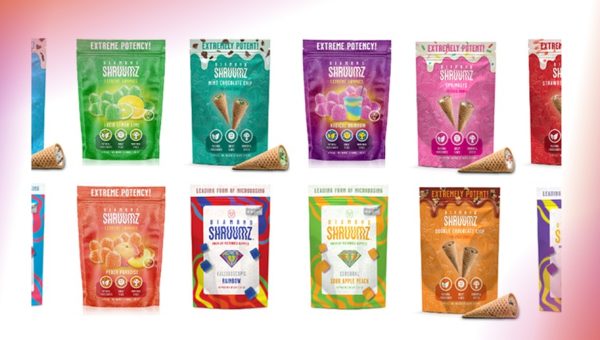
Illness Potentially Associated with Consuming Diamond ShruumzTM Brand Chocolate Bars, Cones, and Gummies -CDC Warning
The Centers for Disease Control and Prevention (CDC), Food and Drug Administration (FDA), America’s Poison Centers, and state and local partners are investigating reports of severe acute illnesses potentially associated with consuming Diamond ShruumzTM brand chocolate bars, cones, and gummies marketed as containing a proprietary blend of mushroom. As of June 11, 2024, 12 total illnesses and 10 hospitalizations have been reported in eight U.S. states with ongoing efforts to identify other potential cases. The cause of the reported illnesses is not known at this time. Individuals should not eat, sell, or serve any flavors of Diamond ShruumzTM brand chocolate bars, cones, or gummies, and should discard products that have been purchased. CDC and FDA are working to determine whether other products from this company are associated with adverse health effects.
Background:
CDC and FDA have received reports of severe acute illnesses and other adverse effects following consumption of Diamond ShruumzTM brand chocolate bars, cones, and gummies reported to multiple poison control centers across the United States. These products are distributed online and at retailers including those that that sell hemp-derived (e.g., cannabidiol [CBD], delta-8 tetrahydrocannabinol [THC]) and smoke/vape products nationwide.
Products containing psychoactive compounds such as cannabis or mushroom extracts are increasing in availability. These “edibles” are often sold as gummy candies, chocolate, or other snack foods. They might contain undisclosed ingredients, including illicit substances, other adulterants, or potentially harmful contaminants that are not approved for use in food. Mushroom-containing products have been marketed for promoting health or for achieving nonspecific physical or psychoactive effects. Examples of health claims have included improving focus and increasing energy. Advertising for these products has also implied that consumption would lead to feelings of euphoria, hallucinations, or psychedelic effects. Common terms used in marketing include “microdosing,” “adaptogens” (substances to help the body adapt to stress), “nootropics” (substances that enhance memory or cognitive function), or “functional mushrooms.”
Adverse effects reported to U.S. poison centers in 12 patients who sought medical attention after consuming Diamond ShruumzTM brand chocolate bars, cones, or gummies as of June 11, 2024, include central nervous system depression with sedation, seizures, muscle rigidity, clonus, tremor, abnormal heart rate (bradycardia or tachycardia), abnormal blood pressure (hypotension or hypertension), gastrointestinal effects (nausea, vomiting, or abdominal pain), skin flushing, diaphoresis, and metabolic acidosis with increased anion gap. Ten patients were hospitalized, and several patients required intubation, mechanical ventilation, and admission to an intensive care unit. None have died.
CDC, FDA, and America’s Poison Centers are continuing to monitor cases of illness reported to poison centers nationwide. Any suspected cases or adverse effects after consuming any Diamond ShruumzTM brand products should be reported to the Poison Help Line.
Recommendations for Clinicians:
- Counsel patients, caregivers, and guardians not to purchase, consume, or serve Diamond ShruumzTM brand chocolate bars, cones, or gummies.
- Counsel patients, caregivers, and guardians to avoid consuming mushroom-containing edible products claiming to produce neurologic, cognitive, or psychoactive effects.
- Be aware that “edibles” or food-like products marketed with nonspecific health benefits or implied psychoactive effects might contain undisclosed, misformulated, or unapproved ingredients that can cause severe adverse health effects.
- Have a high index of suspicion for severe illness in any patient who recently consumed any of these products presenting to a healthcare facility with any adverse effects. Symptoms might include, but are not limited to, central nervous system depression with sedation, seizures, muscle rigidity, clonus, tremor, abnormal heart rate (bradycardia or tachycardia), abnormal blood pressure (hypotension or hypertension), gastrointestinal effects (nausea, vomiting, or abdominal pain), skin flushing, diaphoresis, and metabolic acidosis with increased anion gap.
- Obtain early consultation with a medical toxicologist with expertise in managing patients with acute unknown ingestions. Contact your local poison center for advice on medical management of these patients.
- Managing symptoms from an unknown exposure primarily involves supportive care and consultation with a poison center or toxicologist. Common treatments include IV fluid hydration, supplemental oxygen, and ventilatory support for respiratory failure. Benzodiazepines might be indicated as first-line medications to treat seizures, muscle rigidity, or agitation. Consider the possibility of concomitant ingestion of other drugs or medications and be aware that other specific antidotes (e.g., naloxone) might be indicated.
- Consider routine diagnostic testing if indicated based on the patient’s clinical presentation. Examples might include, but are not limited to, a comprehensive metabolic panel (CMP), including serum electrolytes, liver enzymes and BUN/creatinine; complete blood count; arterial blood gas; urinalysis; and urine drug screen.
- Consider consulting a neurologist for evaluation and further diagnostic workup such as electroencephalogram (EEG) or imaging studies if there is any concern for status epilepticus. [4]
- Consider retaining urine and blood samples for further testing. Urine drug screens commonly used in healthcare facilities usually only detect a limited number of compounds. Decisions to perform further testing may be based on discussions and coordination with a poison center or local health authorities.
Contact your local public health authority or regional poison center to report cases of illness after consuming mushroom-containing chocolate or other similar edible products.
Recommendations for Public Health Practitioners: Be aware that cases of severe illness have been reported following consumption of Diamond ShruumzTM brand chocolate bars, cones, and gummies.
Educate the public about the risks of eating mushroom-containing edible products marketed with claims of nonspecific physical effects, health benefits, or implied psychoactive effects. Such products might contain potentially harmful undisclosed, misformulated, or unapproved ingredients.
Coordinate with your local poison center (1-800-222-1222) and other relevant stakeholders to discuss any suspected cases of illness due to these products within your jurisdiction and establish preferred processes to collect information on suspected cases.
Recommendations for the Public :
- Do not buy, eat, sell, or serve Diamond ShruumzTM brand chocolate bars, cones, or gummies. Discard and destroy any product that has been purchased.
- Do not consume chocolate, gummies, snack foods, or other edible products claiming to produce feelings of euphoria, hallucinations, or psychedelic effects. They might contain undisclosed ingredients that might be linked to severe illness.
- Store edibles and other products that contain mushrooms, THC, or CBD safely away from children. Children may mistake some edibles for candy.
- Seek immediate medical attention or call the Poison Help Line (1-800-222-1222) for advice if you have consumed a product and are having symptoms. Signs and symptoms may include gastrointestinal effects (nausea, vomiting, abdominal pain), hallucinations, uncontrolled movements, fast or slow heart rate, high or low blood pressure, coughing, choking, excessive sweating or secretions, and flushed skin. Other severe adverse effects have been reported, including seizures, decreased level of consciousness, and respiratory failure.
Consumers are also encouraged to report adverse events related to these products to FDA MedWatch.
For more information please visit: https://emergency.cdc.gov/han/2024/han00509.asp
Image credit: www.FDA.gov
Author: HealthyLife | Posted on: June 15, 2024
« Herpes Infection Facts, Treatment And Prevention Four Year Old Infected With Bird Flu In India »






















Write a comment